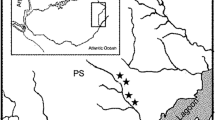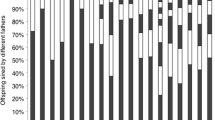Abstract
Individuals of species that change sex from male to female may gain a “size advantage” from that sex change; that is, as males become larger, they become female, thus increasing their fecundity with their size. However, males could also gain an early and different reproductive size advantage by choosing large females as mates. While male preference for large females has been observed in many dioecious species, we know little about male size preference in sex-changing species. In choice experiments, we examined whether males of two congeneric species of marine sex-changing snails, Crepidula fornicata and C. convexa, chose large females over small ones as partners. We also used choice tests to see whether males of C. fornicata, a species whose members form long-term, multi-animal stacks, would choose two females in a stack over a single female. Surprisingly, males of neither species showed a preference for large females, in spite of the documented fecundity advantage associated with large female-size. Males of C. fornicata chose slightly, but not significantly, more single females than stacks, suggesting that neither number nor size drives mate choice in these animals. Key factors that may influence this lack of size preference include long association time, the likelihood of sperm competition, and the cost of extended mate search; it may also be that sex-change itself, the very factor that creates female-biased sexual size dimorphism in these species, prevents size preference, as males may gain sufficient reproductive advantage from eventually becoming large females themselves to offset any benefit of choosing large females.




Similar content being viewed by others
References
Ambrogio OV, Pechenik JA (2008) When is a male not a male? Sex recognition and choice in two sex-changing species. Behav Ecol Sociobiol 62:1779–1786. doi:10.1007/s00265-008-0606-4
Andersson M (1994) Sexual selection. Princeton University Press, Princeton
Backwell PRY, Passmore NI (1996) Time constraints and multiple choice criteria in the sampling behaviour and mate choice of the fiddler crab, Uca annulipes. Behav Ecol Sociobiol 38:407–416
Basolo AL (2004) Variation between and within the sexes in body size preferences. Anim Behav 68:75–82
Bateman PW, Fleming PA (2006) Males are selective too: mating, but not courtship, with sequential females influences choosiness in male field crickets (Gryllus bimaculatus). Behav Ecol Sociobiol 59:577–581
Bel-Venner MC, Dray S, Allaine D, Menu F, Venner S (2008) Unexpected male choosiness for mates in a spider. Proc R Soc Lond B Biol Sci 275:77–82
Bonduriansky R (2001) The evolution of male mate choice in insects: a synthesis of ideas and evidence. Biol Rev 76:305–339
Borg AA, Forsgren E, Amundsen T (2006) Seasonal change in female choice for male size in the two-spotted goby. Anim Behav 72:763–771
Cardoso RS, Costa DS, Loureiro VF (2007) Mating behaviour of the marine snail Littoraria flava (Mollusca: Caenogastropoda) on a boulder shore of south-east Brazil. J Mar Biol Assoc UK 87:947–952
Coe W (1938a) Conditions influencing the change of sex in mollusks of the genus Crepidula. J Exp Biol 122:5–19
Coe W (1938b) Influence of association on the sexual phases of gastropods having protrandric consecutive sexuality. Biol Bull 75:274–285
Coe WR (1953) Influences of association, isolation, and nutrition on the sexuality of snails of the genus Crepidula. J Exp Zool 122:5–19
Collin R (1995) Sex, size, and position: a test of models predicting size at sex change in the protandrous gastropod Crepidula fornicata. Am Nat 146:815–831
Dupont L, Richard J, Paulet YM, Thouzeau G, Viard F (2006) Gregariousness and protandry promote reproductive insurance in the invasive gastropod Crepidula fornicata: evidence from assignment of larval paternity. Mol Ecol 15:3009–3021
Gaffney PM, McGee B (1992) Multiple paternity in Crepidula fornicata (Linnaeus). Veliger 35:12–15
Ghiselin M (1969) The evolution of hermaphroditism among animals. Q Rev Biol 44:189–208
Gwynne DT (1991) Sexual competition among females––what causes courtship-role reversal? Trends Ecol Evol 6:118–121
Hendler G, Franz DR (1971) Population dynamics and life-history of Crepidula convexa Say (Gastropoda-Prosobranchia) in Delaware Bay. Biol Bull 141:514
Herdman EJE, Kelly CD, Godin JGJ (2004) Male mate choice in the guppy (Poecilia reticulata): Do males prefer larger females as mates? Ethology 110:97–111
Hoagland KE (1978) Protandry and the evolution of environmentally mediated sex change: a study of the Mollusca. Malacologia 176:365–391
Hoefler CD (2007) Male mate choice and size-assortative pairing in a jumping spider, Phidippus clarus. Anim Behav 73:943–954
Johnson L (1999) Size assortative mating in the marine snail Littorina neglecta. J Exp Mar Biol Ecol 79:1131–1132
Lehmann GUC (2007) Density-dependent plasticity of sequential mate choice in a bushcricket (Orthoptera: Tettigoniidae). Aust J Zool 55:123–130
Li W, Pechenik JA (2007) Effect of inbreeding on reproduction and juvenile performance in two marine gastropods with contrasting reproductive patterns. Mar Ecol Prog Ser 346:219–234
Lynch KS, Rand AS, Ryan MJ, Wilczynski W (2005) Plasticity in female mate choice associated with changing reproductive states. Anim Behav 69:689–699
Megina C, Cervera JL (2003) Diet, prey selection and cannibalism in the hunter opisthobranch Roboastra europaea. J Mar Biol Assoc UK 83:489–495
Muñoz R, Warner R (2003) A new version of the size-advantage hypothesis for sex change: incorporating sperm competition and size-fecundity skew. Am Nat 161:749–761
Orton J (1909) On the occurrence of protandric hermaphroditism in the mollusc Crepidula fornicata. Proc Roy Soc London 81:468–484
Pechenik JA, Gee CC (1993) Onset of metamorphic competence in larvae of the gastropod Crepidula fornicata (L.), judged by a natural and an artificial cue. J Exp Mar Biol Ecol 167:59–72
Poschadel JR, Meyer-Lucht Y, Plath M (2006) Response to chemical cues from conspecifics reflects male mating preference for large females and avoidance of large competitors in the European pond turtle, Emys orbicularis. Behaviour 143:569–587
Preston BT, Stevenson IR, Pemberton JM, Coltman DW, Wilson K (2005) Male mate choice influences female promiscuity in Soay sheep. Proc R Soc Lond B Biol Sci 272:365–373
Proestou D, Goldsmith M, Twombly S (2008) Patterns of male reproductive success in Crepidula fornicata provides new insight for sex allocation and optimal sex change. Biol Bull 214:194–202
Ptacek MB, Travis J (1997) Mate choice in the sailfin molly, Poecilia latipinna. Evol Int J org Evol 51:1217–1231
Rahman N, Dunham DW, Govind CK (2002) Size-assortative pairing in the big-clawed snapping shrimp, Alpheus heterochelis. Behaviour 139:1443–1468
Reading KL, Backwell PRY (2007) Can beggars be choosers? Male mate choice in a fiddler crab. Anim Behav 74:867–872
Shine R, Philips B, Waye H, LeMaster M, Mason R (2003) The lexicon of love: what cues cause size-assortative courtship by male garter snakes? Behav Ecol Sociobiol 53:243–237
Shine R, Webb JK, Lane A, Mason RT (2006) Flexible mate choice: a male snake’s preference for larger females is modified by the sizes of females encountered. Anim Behav 71:203–209
Warner R, Fitch D, Standish J (1996) Social control of sex change in the shelf limpet Crepidula norrisiarum: size-specific responses to local group composition. J Exp Mar Biol Ecol 204:155–167
Author information
Authors and Affiliations
Corresponding author
Additional information
Communicated by M. Byrne.
Rights and permissions
About this article
Cite this article
Ambrogio, O.V., Pechenik, J.A. Do sex-changing male snails use mate choice to get a jump on their “size advantage”?. Mar Biol 156, 2173–2180 (2009). https://doi.org/10.1007/s00227-009-1247-5
Received:
Accepted:
Published:
Issue Date:
DOI: https://doi.org/10.1007/s00227-009-1247-5




